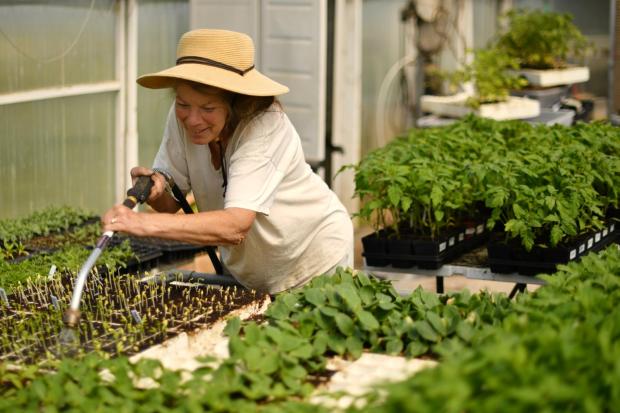BRIGHTON — The founder of this city, Daniel F. Carmichael, thought so highly of the agrarian landscape that spilled out from the north edge of Denver that he “determined there should be a town here that would be a credit to the splendid valley of the Platte.”
More than a century after Carmichael’s death — and the publication of the obituary that marked his passing in 1911 — the “splendid valley” moniker has been resurrected to mark, and hopefully protect, an agrarian expanse south of Brighton that has yet to be populated with rows of single-family homes, strip malls and mid-rise office towers.
Historic Splendid Valley, a brand affixed to 5,000 acres of mostly fertile farmland at the northeast corner of U.S. 85 and E-470, was launched last month as part of a joint effort between Brighton and Adams County. The purpose behind dusting off the old name, said Anneli Berube, is to give people “that connection to their food and that connection to their history and roots” in a metro area that is quickly losing the links to its farming past.
Berube, agricultural innovation specialist for Brighton and Adams County, said Historic Splendid Valley can serve as a showcase for local food production, agri-tourism, farm-to-table restaurants, and food storage and processing facilities. Petrocco Farms, which got its start in Colorado in 1916, calls the valley south of Brighton home.
“That agricultural heritage is what will continue to draw people to the area,” she said.

It’s proved to be a winning formula for Tim and Claudia Ferrell, owners of Berry Patch Farms, a working farm and pick-your-own produce business at the west edge of Historic Splendid Valley. Squash, okra, tomatoes, peas, spinach, lettuce, cilantro, kale, chard, onions, black raspberries, strawberries, melons — the Ferrells grow it all on their 40 acres.
“This is great soil for vegetables and a great climate for vegetables,” Claudia Ferrell said on a particularly sun-drenched day in late May.
When the couple first bought their farm in 1998, her husband said, they toyed with the idea of selling off 10 acres that were zoned residential to a homebuilder. It only took six months for them to jettison that plan.
“What were we thinking?” said Tim Ferrell, as a handful of chickens wandered his way and took refuge from the sun under a picnic table. “We rezoned it to ag and took down the for-sale sign. We fell in love with the land.”
Development pressure
But the land in Historic Splendid Valley has many owners with many different motivations, prompting Adams County and Brighton to join forces three years ago to protect as much of it as possible. They hammered out what is called the District Plan “to study the feasibility of preserving farmland in southern Brighton that remains valuable for food production, while allowing for a range of development opportunities that consider the most efficient and sustainable use of the land.”
Since 2003, Brighton has purchased 250 acres in and around the valley to keep as farmland, while last month Adams County used open space tax dollars to buy 38 acres in Splendid Valley from the Murata family, which since the 1960s had grown vegetables for the Denver market. The family also grew sugar beets that they sold to the Great Western Sugar Co. and green beans and pickled cucumbers they supplied to the Kuner-Empson Cannery in Brighton.

Adams County’s purchase included 30 shares of Fulton Ditch water.
In all, the city and county have spent $12.5 million on land in Historic Splendid Valley. Berube said there are an additional 78 acres under an agricultural easement, which means the property owner receives a tax break for keeping the land as is.
Berube acknowledges that preserving just 366 acres out of 5,000 isn’t much, but she said the District Plan calls for more property acquisition in the valley over the coming decades.
“It’s the early days,” she said. “We’re still looking for opportunities.”
Those opportunities will be competing with the private sector and the inexorable growth pressures that have been felt up and down the Front Range over the last few years.
Several large parcels in Historic Splendid Valley were annexed into Brighton years ago and are slated for homes and commercial uses, such as Adams Crossing and Brighton Lakes (recently renamed Farmlore).
But Berube said the city and county can do what they can to ensure that what development does take place in Historic Splendid Valley is carried out as wisely as possible.
“If the housing can be clustered so there is still good open space and ag land that is preserved, that is one way to work with developers,” she said.
The District Plan states a goal of preserving 20 percent of the Historic Splendid Valley as “open space/farmland” by 2035.

“It’s not too late”
Some of the best perspective on the why behind preserving farmland near Brighton comes from those who have lived there a long time and remember what it was like before the big-box stores and fast-casual restaurants came to Bromley Lane.
Alan Hale, chairman of the District Plan, lives right in the middle of Historic Splendid Valley — near where the Fulton Ditch cuts through pastures southwest to northeast, making farming possible in the valley in the first place.
“We have seen this farmland gobbled up for some dubious purposes,” Hale said. “There are right places for everything — for residential, for commercial, for agricultural. We were rapidly losing our heritage and what made us who we are.”
He points to a storage facility off of Sable Boulevard, a road that runs through the heart of Historic Splendid Valley and only too well illustrates the collision of the area’s agricultural past with its suburban present. The storage facility was built on what was considered one of the most productive parcels of farmland in the area, Hale said.
Related Articles
-
Suburbs north of Denver have “come of age” with explosive growth along I-25 corridor
-
Brighton safeguards farmland amid rapid growth
-
As development eats away at Denver’s green space, the “city within a park” is becoming a concrete metropolis
“I have no problem with storage units,” he said. “I have a problem with storage units on prime agricultural land. I am not a no-growther — I believe in smart growth. And if we fail now, it’s lost.”
Brighton Mayor Ken Kreutzer, 59, has lived in the city his entire life. He has seen Brighton double in size in the last 20 years to more than 40,000 people, and with that growth, residents want amenities and conveniences that necessarily make demands on available land.
But the mayor doesn’t want to bleed into Commerce City, Thornton and Denver in one endless rolling sea of concrete. Historic Splendid Valley provides a critical buffer between Brighton and the rest of the metro area.
“The challenge for me is to keep that small-town feeling but give people the growth they want,” Kreutzer said. “There just needs to be a nice balance.”
Berube, the District Plan’s coordinator, said there’s still enough living history in play south of Brighton that it can be saved — and the connection to the area’s century-old heritage maintained.
“It’s not too late here,” she said.



